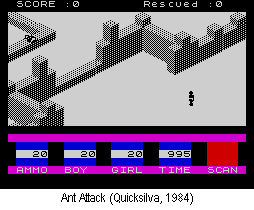|

By Lloyd Mangram
February
1984
Issue 1
 |
The
'Chairman', as he's now known, hangs in the Newsfield
boardroom. This first cover of CRASH was not based on
any particular game, but took its inspiration from the
chrome-teethed, machine-oil-dripping alien from the
film Alien. It's really a simple gag - an alien
playing Space Invaders, the screen reflected
in his eyes. The object was to provide a striking and
ferocious image to leap off the news shelves, and to
declare to the world that CRASH was very different to
existing computer magazines with their reliance on photographed
hardware.
|
Work started on the first issue of CRASH well before Christmas
1983. The editorial team, which was to remain unchanged for
three months, consisted of Roger Kean, Oliver Frey, Lloyd
Mangram and Matthew Uffindell, a 17-year-old who had been
buying software from Crash Micro Games Action mail order.
As he lived nearby, he popped in to purchase games and somehow
never quite left. Many of CRASH's early reviewers were recruited
in this fashion. Matthew now works in Newsfield's art department
as a senior film planner - one of the people who put the images
on film, ready for the printers.
At the 1983 PCW Show, held at the Barbican that year, Roger
Kean and CRASH financial director Franco Frey roved around
the stands trying to convince software houses that a really
new magazine was about to arrive. Interest was generally luke
warm, but nevertheless, by mid-December when the issue had
to be ready, 27 pages of advertising had been sold - enough
to provide CRASH with the funds to print!
The original concept behind CRASH had been to provide a low-key,
low-cost magazine, mostly in monochrome, to attract the numerous
software houses who couldn't afford the advertising rates
of the existing glossies, so several of the first issues were
printed on cheap newsprint with a heavier colour section wrapped
around. As it turned out, most advertisers opted for colour
advertisements and so gradually CRASH became as glossy (and
as expensive to advertise in) as the rest. It was while Roger
was driving to Milton Keynes to watch the first colour coming
off the press that he was stopped by the police for speeding
- at 3.30 in the morning. On explaining to the officers that
he was rushing to a birth, he was let off with a caution.
He's never broken a speed limit since . .
 Issue
One had lots to offer, including an amazing 60 reviews, the
first time ever so much space had been devoted to Spectrum
games. Among them were notables like Zaxxan from Starzone,
a bunch of youngsters who later got into a legal wrangle with
US Gold when the official version of Zaxxon was released,
Bugaboo (The Flea) from Quicksilva, which got 92% and
would have been a Smash had there been Smashes in those days,
and of course the Game of the Month, Micromega's 3-D Deathchase
- still a great thrill to play. Programming innovations were
still largely a thing of the future, but Sandy White's Ant
Attack (Quicksilva) raised some eyebrows, although I remember
Matthew and I feeling that it lacked something in the gameplay. Issue
One had lots to offer, including an amazing 60 reviews, the
first time ever so much space had been devoted to Spectrum
games. Among them were notables like Zaxxan from Starzone,
a bunch of youngsters who later got into a legal wrangle with
US Gold when the official version of Zaxxon was released,
Bugaboo (The Flea) from Quicksilva, which got 92% and
would have been a Smash had there been Smashes in those days,
and of course the Game of the Month, Micromega's 3-D Deathchase
- still a great thrill to play. Programming innovations were
still largely a thing of the future, but Sandy White's Ant
Attack (Quicksilva) raised some eyebrows, although I remember
Matthew and I feeling that it lacked something in the gameplay.
Then there was the fabled Living Guide, which was to run
for the first four issues before it became too unwieldy to
cope with. It listed every game you could lay your hands on
under classified headings like 'Platformers', 'Maze Games'
and so on. Matthew and another young reviewer, Chris Passey,
provided a comparison of Invader/Galaxian games in Run It
Again, Franco reviewed and compared joystick interfaces, we
launched the first ever readers' hotline chart, and offered
readers the chance to become a CRASH reviewer in a competition.
Interestingly, one of its runners-up was a young man by the
name of John Minson, but more of him much later . . .
We also profiled Rabbit Software, Blaby Games and Carnell,
who were finishing their much-heralded Wrath of Magra.
And to round off, I did my first ever look back at the software
year. The weakest spot in that first CRASH (and for several
issues) was the lack of a proper adventure reviewer. Buried
deep in the Living Guide were mini reviews of Star Trek
and Velnor's Lair, two games from a tiny outfit called
Neptune, operated by one Derek Brewster . . .
|